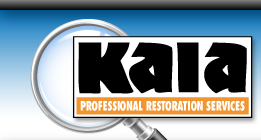WATER DAMAGE
The Five Stages of Water Damage
Stage 1: The free-flow of water by gravity.
Gravity will level out standing water and cause ft to find cracks in the floor, plumbing penetrations and many other openings. This affects the floors below as well as other adjacent spaces. Quick action at earlier stages of water damage will reduce the costs and resulting cleanup. On the other hand, delaying action increases both exponentially.
Stage 2: The wicking of moisture into materials that is in direct contact with standing water.
Damage continues to increase as long as free-water touches gypsum board, wood floors, furniture and documents due to the tendency of materials to draw in moisture through capillary action. This damage is mitigated by quick and thorough water-extraction, as it will remove the free-water and stop the wicking. Effective action at this stage will drastically reduce the time and effort to dry out the wet building materials.
Stage 3: High humidity damage.
This occurs when the moisture on and in the wet materials begins to evaporate, saturating the surrounding air. Previously unaffected materials now take on moisture. Early signs of high humidity damage include condensation forming on walls, ceiling tiles sagging from high moisture content and paper stock taking on moisture to the point it cannot be used for copying.
This damage is mitigated by controlling the relative humidity inside the building through the use of high-capacity LGR dehumidifiers. Quick action at this stage will keep the moisture content of the building material and contents below the threshold at which they will support microbial growth.
Stage 4: Active microbial growth.
This begins when materials have taken on sufficient moisture to be able to support mold. The threshold for most cellulose-based material (i.e., wood, documents and the paper covering on gypsum board) is when their moisture content exceeds 20 to 25 percent of their weight.
Reducing this damage is accomplished by controlling three key conditions of the building's air relative humidity, temperature and air circulation. Controlling these will create an environment that will rapidly dry the materials back to their pre-loss moisture content. Effective action at this point will generally confine the damage to the area that was directly affected by the water damage event.
Stage 5: The spread of microbial to other, originally unaffected areas of the building.
The spread of microbial (i.e., mold, odors and other pathogens) may eventually occur due to unchecked microbial growth in the affected area, the movement of people throughout the building, air circulation systems and/or elevator movement from floor-to-floor. If this stage of water damage occurs, a comprehensive plan must be put together involving various indoor air quality professionals and contractors.
Quick and effective action at the earliest possible stage will reduce interruption to the business, reduce overall restoration costs and increase the likelihood that irreplaceable items will still be usable. This type of needed action can be facilitated by contacting our 24 hour number for Immediate assistance. Our fleet of dehumidifiers and turbo dryers will be ready to go at a moments notice.
Our goal is to recover not replace your valuables.
We understand budgets and job costs, water damage doesn't have to impact your bottom line. When a water issue occurs it is usually a direct result of poor workmanship or failed materials. Someone should be held accountable for your damages. Our documentation depicts cause and origin, which will help you defend and enforce charge backs to your subcontractors or suppliers.


